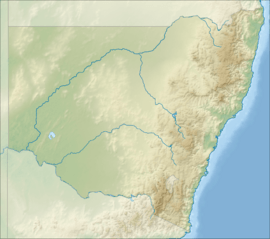Moore Park Nature Reserve facts for kids
Quick facts for kids Moore Park Nature ReserveNew South Wales |
|||||||||
|---|---|---|---|---|---|---|---|---|---|
|
IUCN Category IV (Habitat/Species Management Area)
|
|||||||||

dry rainforest at Moore Park Nature Reserve
|
|||||||||
| Nearest town or city | Kyogle | ||||||||
| Postcode(s) | 2474 | ||||||||
| Elevation | 78 m (256 ft) | ||||||||
| Area | 9 ha | ||||||||
| Managing authorities | NSW National Parks & Wildlife Service | ||||||||
| Website | Moore Park Nature Reserve | ||||||||
|
|||||||||
| See also | Protected areas of New South Wales |
||||||||
Moore Park Nature Reserve is a special protected area in Northern New South Wales, Australia. It's a small piece of what's called a "dry rainforest." This reserve is located where Findon Creek flows into the Richmond River. Long ago, it was part of a much larger forest known as Boyd's Scrub. Today, a big group of flying foxes makes their home in this rainforest.
Contents
About Moore Park Nature Reserve
Moore Park Nature Reserve is a small but important natural area. It protects a rare type of forest called a dry rainforest. These forests are special because they grow in areas that don't get as much rain as typical rainforests. The reserve is managed by the NSW National Parks & Wildlife Service. They work to keep this unique habitat safe for all the plants and animals that live there.
What is a Dry Rainforest?
When you hear "rainforest," you might think of places that get a lot of rain all year. A dry rainforest is a bit different. It still has many trees and plants, but it grows in areas with less rainfall. These forests often have trees that can handle drier conditions. They are also very important because they are quite rare. Moore Park Nature Reserve is a great example of this special kind of forest.
Amazing Trees of the Reserve
The forest in Moore Park Nature Reserve is home to some really impressive trees. One of the most famous is a giant Moreton Bay Fig. This tree is huge and stands out in the forest.
Other tall trees that form the forest canopy include:
- The Black Bean tree, which has beautiful flowers and large, dark seeds.
- The Silky Oak, known for its golden-orange flowers.
- The Plum Pine, which produces small, plum-like fruits.
- The Native Elm, another important tree in the forest.
These trees provide shelter and food for many animals in the reserve.
Meet the Flying Foxes
One of the most exciting things about Moore Park Nature Reserve is the large group of flying foxes that live there. Flying foxes are a type of bat, but they are much bigger than the small bats you might see at night. They mostly eat fruit and nectar from flowers.
During the day, these flying foxes hang upside down from trees, resting. At dusk, they fly out in large numbers to find food. It's an amazing sight to see them all take off! They play a very important role in the rainforest by helping to pollinate flowers and spread seeds.


